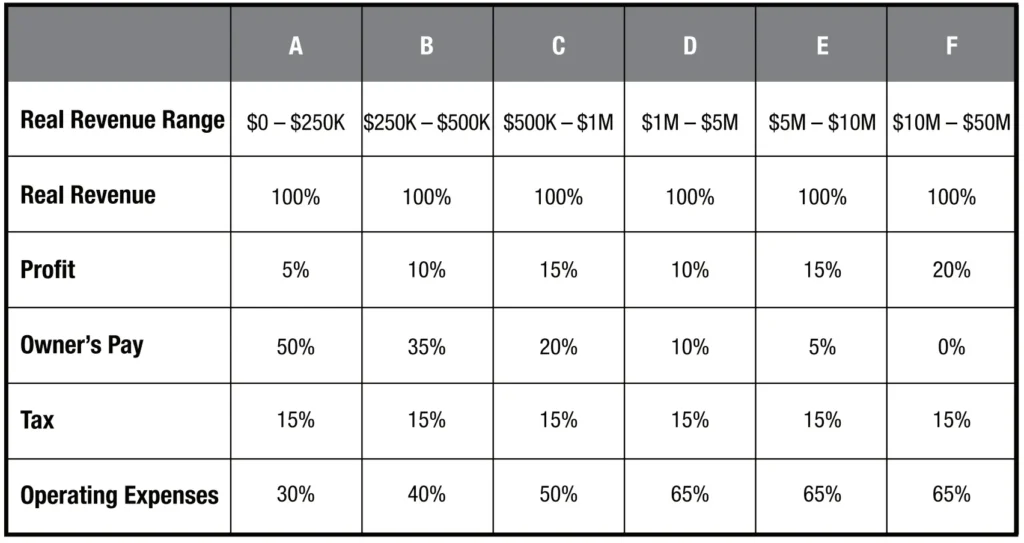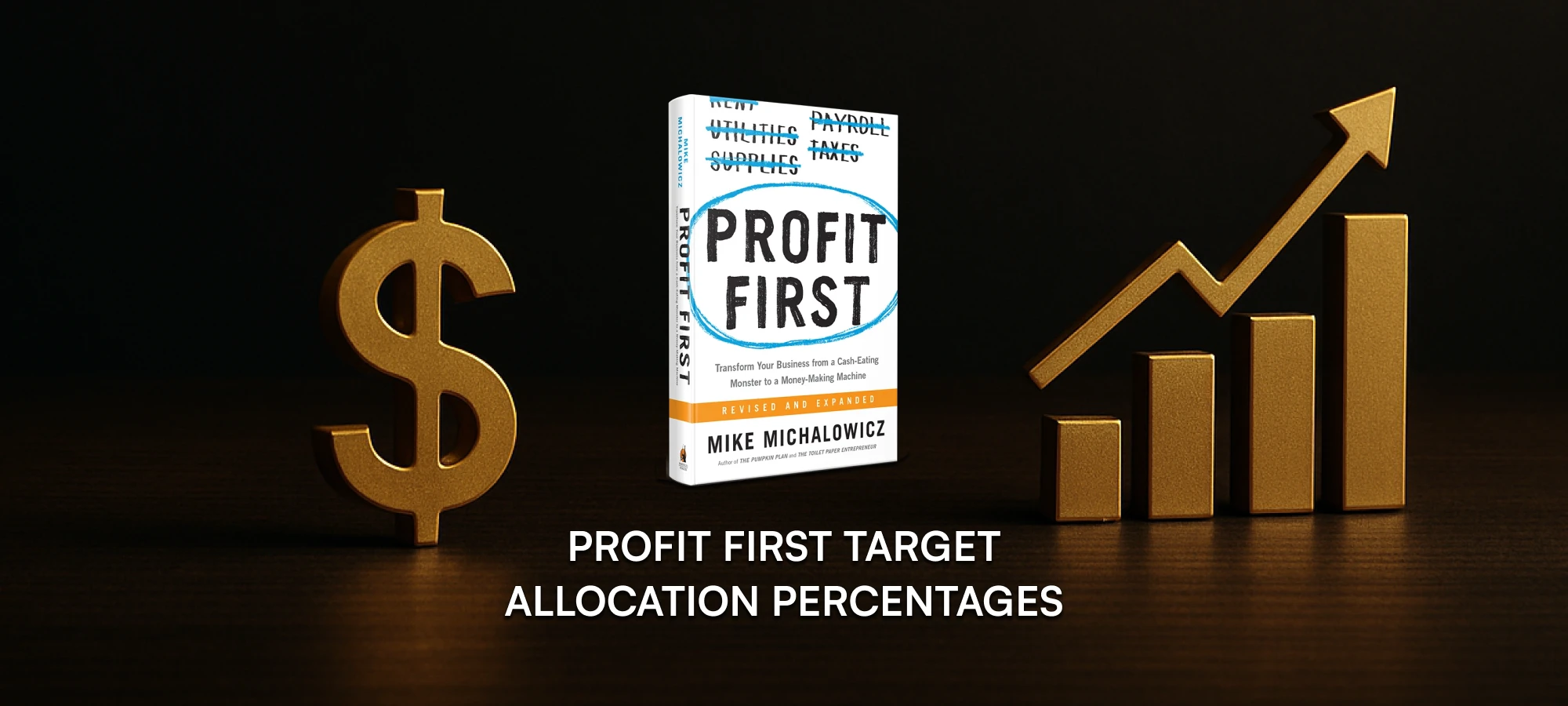This is where most business owners hesitate. Not because the system’s unclear, but because they’re afraid to get the numbers wrong.
But this part isn’t about being right. It’s about getting started.
There’s no perfect percentage. Your allocations should match your stage, your margins, and your current cash flow. Not someone else’s formula.
This chapter gives you a starting point and a system to adjust as you grow.
Start small. Stay consistent. Let the habit compound. Now let’s get to it:
The Most Common Question: “What Percentages Should I Use?”
Once you’ve set up your Profit First bank accounts, the next question is inevitable:
“Okay… but how much do I actually move into each one?”
There’s no one-size-fits-all answer. And that’s good news. Because your allocations should reflect your business stage, your goals, and your current cash flow reality not someone else’s blueprint.
This chapter gives you a clear starting point, but more importantly, it gives you a system to evolve your percentages over time.
Many entrepreneurs freeze here, afraid of getting the numbers wrong. But the power of Profit First isn’t in precision it’s in rhythm. You can start small and improve as you go. Progress beats perfection every time.
How Allocation Percentages Work
On each allocation day (typically twice per month), you move a percentage of your current Income Account balance into each of the other accounts.
For example, if you receive $10,000 and your allocation is:
- 5% Profit → $500
- 50% Owner’s Pay → $5,000
- 15% Tax → $1,500
- 30% OPEX → $3,000
Then that’s how your funds get divided on allocation day. Simple.
Profit First Target Allocation Percentages (TAPS)
Note: this section is not in the ebook.
This TAPS table lists the target allocation percentages by revenue range, and can be found in the original book, Profit First by Mike Michalowicz:

We’ve further tailored this for our target clientele below, and added notes relevant to service-based businesses in the $1-$20M range:
Allocation Benchmarks by Business Stage
We’ve broken this into three stages based on what we’ve seen work across hundreds of service-based businesses. These are starting points, not hard rules.
If you’re not sure which stage you’re in, default to the one where cash flow currently feels tightest. Start conservatively, and adjust quarterly.
Stage 1: Survival Mode ($0 – $500K Revenue)
The goal here is stability. You’re likely still underpaying yourself, unsure about taxes, and trying to get out of debt or inconsistency.
Suggested Allocations:
- 1–2% → Profit
- 30–50% → Owner’s Pay
- 10–15% → Tax
- 3% → Opportunity Account
- Remainder → OPEX: This is what your business operates on. Monitor this number closely if it consistently feels too tight, it’s a signal to review expenses or reevaluate your pricing and delivery model.
Start with tiny Profit allocations. Build the habit, then increase.
You might feel selfish prioritizing your own pay, especially if team members or vendors are depending on you. But when the business owner isn’t stable, the business isn’t either.
Stage 2: Growth Mode ($500K – $2M Revenue)
You’ve moved past survival. The business is growing but your systems might not have caught up. The focus now is sustainability and cash discipline.
Suggested Allocations:
- 5–10% → Profit
- 25–35% → Owner’s Pay
- 15% → Tax
- 5% → Opportunity Account
- Remainder → OPEX: This is what your business operates on. Monitor this number closely if it consistently feels too tight, it’s a signal to review expenses or reevaluate your pricing and delivery model.
This is where you start getting more aggressive with margin. The Opportunity Account also becomes more useful for hiring, marketing, or weathering slower months.
Review these allocations quarterly. Each 90-day window should show progress even if it’s small.
Stage 3: Scaling Mode ($2M – $5M+ Revenue)
Your focus is now on margin, team leverage, and operational efficiency. You’re likely building a leadership team, scaling delivery, and preparing for major moves.
Suggested Goal Allocations:
- 10–15% → Profit
- 15–20% → Owner’s Pay (shift may include W-2 + distributions for tax optimization and personal wealth planning)
- 15–20% → Tax
- 5–10% → Opportunity Account
- Remainder → OPEX: This is what your business operates on. Monitor this number closely if it consistently feels too tight, it’s a signal to review expenses or reevaluate your pricing and delivery model.
This is where Profit First becomes a strategic finance engine, not just a survival tool. Every allocation supports a larger vision growth, acquisition, or reinvestment.
At this level, most of your decisions are about team, risk, and opportunity cost. Having structured, pre-allocated capital removes guesswork and emotional friction.
Profit First Troubleshooter
Problem: “My OPEX account is always running short.”
Solution:
- Your business might be over-leveraged. Review recurring expenses.
- Temporarily reduce Profit/Opportunity allocations and rebuild them gradually.
- Are you allocating based on the cash that has actually landed in your Income account or on the invoices you’ve sent out? Only allocate based on collected revenue. Invoiced money isn’t real until it clears.
Problem: “I’m scared to start allocating to Profit when cash is tight.”
Solution:
- Start with 1%. Build the habit before the volume.
- Remember: Profit is a muscle. If you don’t train it now, it won’t be there when you need it.
- Even allocating $10 builds discipline and identity as a profitable operator.
Problem: “My taxes still feel unpredictable.”
Solution:
- Ensure you’re allocating 10–20% of all collected revenue not just profit.
- Don’t use the Tax account for emergencies. It’s sacred.
- Speak with a tax advisor quarterly and adjust if needed.
Preview: Strategic Finance Layer
Once you’ve stabilized your allocations, the next level is turning this into an insight system. In later chapters, we’ll show you how to:
- Pair Profit First with forecasting and cash flow dashboards
- Review allocations alongside KPIs (Cost per Lead, CAC, payroll efficiency)
- Use the Opportunity Account to fund strategic growth instead of dipping into OPEX or taking loans
Your First Step
Pick your stage. Set your percentages. Use small, simple numbers.
If all you do this week is set 1% to Profit, 1% to Tax, and 1% to Owner’s Pay you’ve started. You’re now leading with intention.
Ready to set up Profit First the right way?
We’ll walk you through the accounts, get your allocations dialed in, and make sure your cash flow stays predictable from day one. Talk to a Profit First Professional to get started.
This was a chapter form the upcoming ebook Profit First, Unofficial: A CFO’s Playbook for Owners. In the next chapter, learn about Profit First and the changes needed to apply it to S Corps.
The previous chapter covered How to Set Up Your Profit First Bank Accounts Without Screwing It Up.


